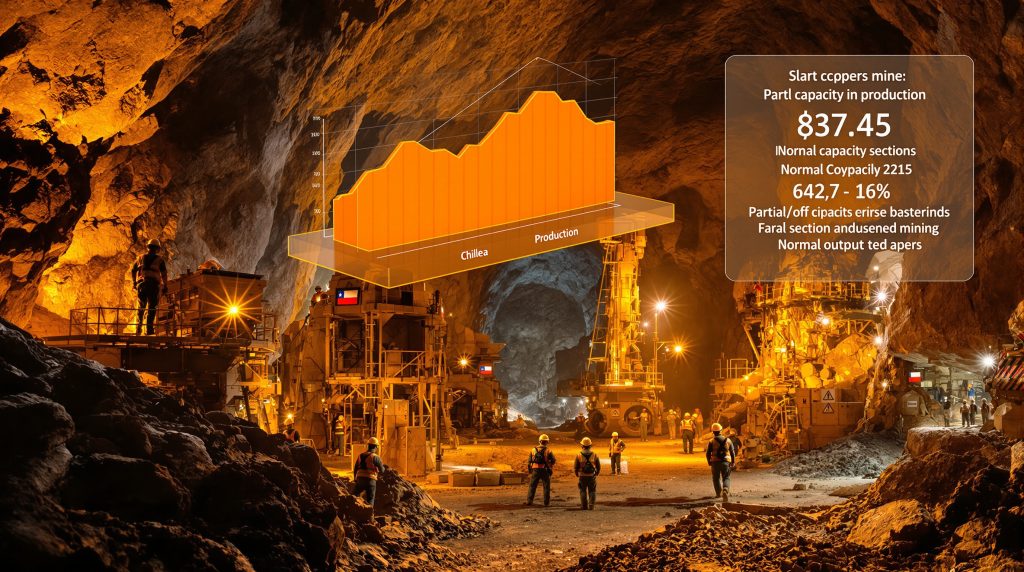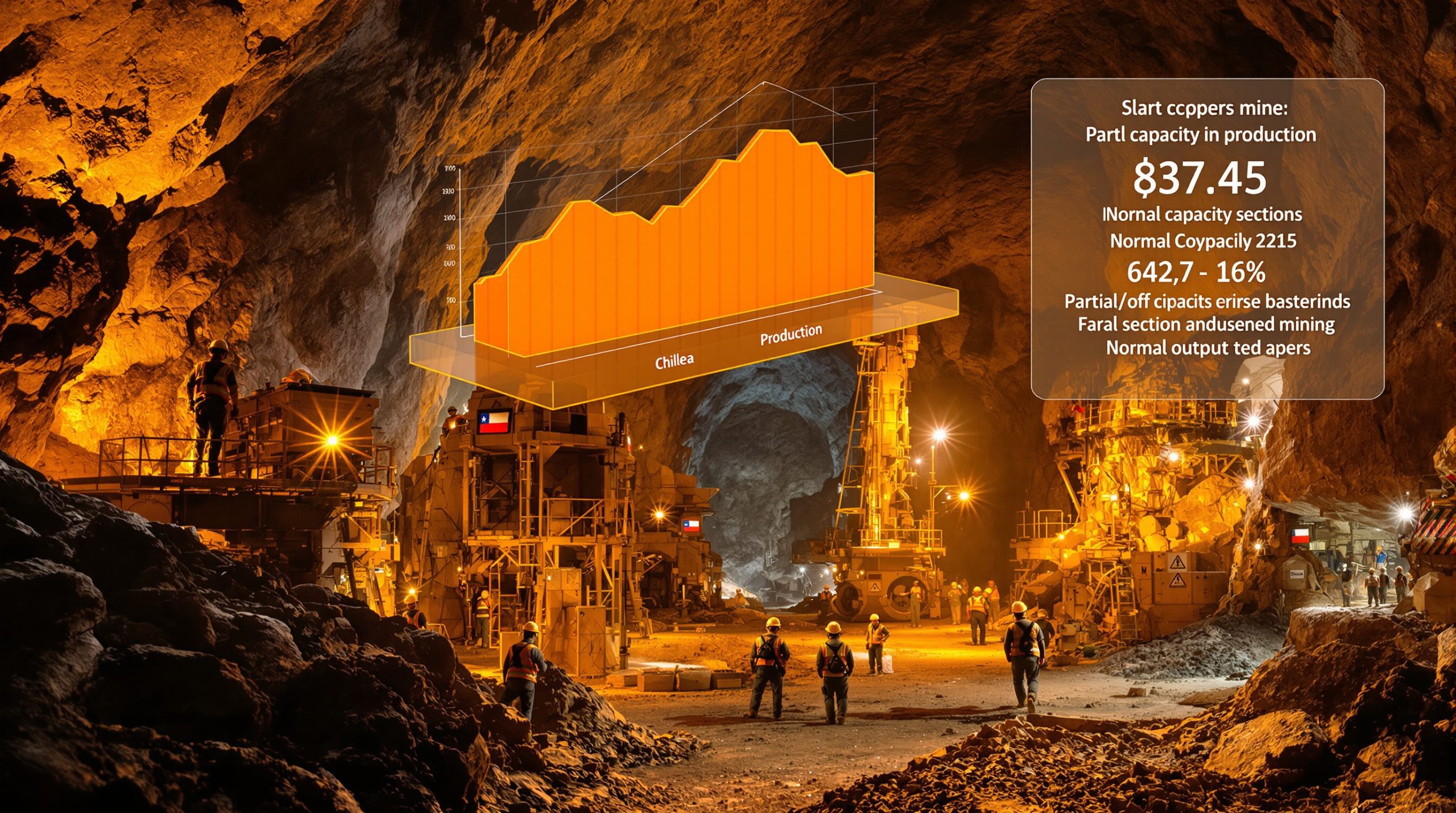Codelco Secures Partial Reopening Approval for El Teniente Copper Mine Following July Accident
Chile's state-owned mining giant Codelco recently received approval to partially resume operations at its iconic El Teniente copper mine after a significant safety incident forced a shutdown. Mining regulator Sernageomin has authorized the restart of two key operational sections while maintaining restrictions on others, highlighting the complex balance between production needs and worker safety in one of the world's most significant copper mining operations.
What Happened at El Teniente Copper Mine?
The July 31 Accident and Operational Suspension
On July 31, 2024, El Teniente copper mine experienced a serious safety incident that prompted Chilean mining regulator Sernageomin to order an immediate suspension of four key operational sections. This comprehensive shutdown represented a significant blow to Codelco's production capabilities during a period of heightened global demand for copper.
The severity of the incident triggered Sernageomin's swift intervention under Chile's stringent mining safety protocols. These regulations require immediate operational suspensions following serious safety incidents until comprehensive evaluations can determine the root causes and implement necessary remediation measures.
The suspension affected four crucial operational areas: Andes Norte, Diamante, Recursos Norte, and Andesita sections, collectively representing a substantial portion of El Teniente's production capacity. During the evaluation period, safety inspectors conducted thorough assessments of structural integrity, operational procedures, and emergency response systems across all affected areas.
Approved Reopening of Two Key Sections
Following extensive safety evaluations, Sernageomin recently approved the restart of operations in two of the four suspended sections: Andes Norte and Diamante. This partial reopening represents a significant milestone in Codelco's efforts to restore production capacity while maintaining rigorous safety standards.
Despite this progress, the reopening comes with notable limitations. The Chilean labor inspection office has only authorized a partial workforce return to these areas, indicating ongoing safety concerns that require continued monitoring and potentially additional remediation measures.
The remaining two sections, Recursos Norte and Andesita, continue to operate under full suspension orders. These areas likely present more complex safety challenges requiring additional engineering solutions, structural reinforcements, or procedural updates before Sernageomin will consider authorizing their resumption.
This phased approach to reopening reflects the regulator's commitment to balancing economic considerations with worker safety, providing Codelco with a pathway to gradual production recovery while ensuring all necessary safety measures are properly implemented and verified.
Why Is El Teniente Mine Significant to Global Copper Markets?
El Teniente's Production Profile
El Teniente holds the distinction of being the world's largest underground copper mine, representing a cornerstone of global copper supply forecast. With over a century of continuous operation since its establishment in 1904, the mine has produced millions of tons of copper that has powered everything from electrical grids to renewable energy technologies worldwide.
The mine's massive underground operations extend across hundreds of kilometers of tunnels beneath the Andes Mountains in central Chile. This complex network allows for the extraction of copper ore from various sections simultaneously, contributing to the mine's impressive historical production capacity.
Within Codelco's portfolio, El Teniente stands as a flagship operation alongside other major assets like Chuquicamata and Radomiro Tomic. Its strategic importance stems not only from its production volume but also from its reserves, which ensure decades of future mining potential.
The partial versus full operational status creates significant production differentials. When fully operational, El Teniente contributes substantially to Codelco's overall copper output. The current partial operation of only two sections creates a notable production gap that reverberates through global supply chains.
Codelco's Market Position and Challenges
As the world's largest copper producer, Codelco plays a pivotal role in global metals markets. The company's production decisions and operational challenges have outsized impacts on copper availability and pricing worldwide. This recent incident at El Teniente adds to a series of operational challenges the company has faced in recent years.
Codelco's production targets have been under pressure from a combination of factors including aging mines, declining ore grades, and the need for substantial capital investments in modernization projects. The El Teniente disruption compounds these challenges at a time when the company is working to maintain its competitive position.
Market expectations for recovery timeline remain cautiously optimistic following the partial reopening announcement. Analysts anticipate a gradual ramp-up in the reopened sections while recognizing that full operational recovery depends on addressing outstanding safety issues in the remaining closed areas.
When compared to other major copper producers like Freeport-McMoRan, BHP, and Southern Copper Corporation, Codelco's recent operational setbacks highlight the increasing complexity of maintaining production growth in mature mining jurisdictions with enhanced regulatory oversight.
How Does the Reopening Impact Chile's Mining Sector?
Economic Significance for Chile
El Teniente's contribution to national copper exports represents a critical component of Chile's economic stability. As the world's largest copper producer, Chile relies heavily on copper revenues to fund government programs, infrastructure development, and social services.
The partial reopening has significant employment implications for the thousands of workers directly employed at El Teniente and the many more who depend on its operations through supporting industries. While the approved restart allows some workers to return to their positions, those associated with the still-closed sections face continued uncertainty.
In central Chile's O'Higgins Region, El Teniente serves as an economic cornerstone. Local businesses, from equipment suppliers to service providers, depend heavily on the mine's operational status. The partial reopening provides some economic relief to these communities while highlighting their vulnerability to mining disruptions.
For the Chilean government, tax revenue considerations remain paramount. Copper exports generate billions in tax receipts annually, with El Teniente representing a significant portion of this revenue stream. The production limitations from the partial closure directly impact government finances during a period of global economic challenges.
Regulatory Framework and Safety Standards
Sernageomin's role in Chilean mining oversight has evolved significantly over recent decades. The regulator now employs rigorous inspection protocols, technical evaluations, and enforcement mechanisms to ensure compliance with national safety standards. Their management of the El Teniente incident demonstrates this enhanced regulatory approach.
Chile's mining safety protocols have undergone substantial evolution following several high-profile incidents, including the famous 2010 Copiapó mining accident. These events catalyzed regulatory reforms that prioritize worker safety over production considerations, establishing Chile as a leader in mining safety standards across Latin America.
When compared to international mining safety standards, Chile's regulatory framework aligns closely with best practices from mining powerhouses like Australia and Canada. These standards emphasize preventative measures, comprehensive risk assessments, and stringent enforcement mechanisms to minimize accidents.
The El Teniente incident may trigger potential regulatory changes as investigators identify systemic issues that contributed to the safety failure. Such incidents often lead to regulatory refinements that address specific vulnerabilities revealed during the investigation process.
What Are the Technical Aspects of the Reopening Process?
Safety Measures and Operational Modifications
Enhanced monitoring systems implemented post-accident form a critical component of the reopening strategy. These likely include advanced sensor networks to detect early warning signs of structural instability, gas accumulation, or other potential hazards that could compromise worker safety.
Structural reinforcements and engineering solutions represent significant investments required before regulatory approval. These may include additional rock bolting, shotcrete application, improved ventilation systems, and enhanced water management infrastructure to address identified vulnerabilities.
Workforce training and safety protocol updates ensure that returning workers understand new operational procedures, emergency response protocols, and reporting mechanisms. This comprehensive training is essential for maintaining improved safety standards during the resumption of operations.
The phased approach to full operational recovery allows for careful monitoring and adjustment at each stage. This methodical strategy enables engineers and safety specialists to evaluate the effectiveness of implemented solutions under actual production conditions before expanding to additional areas.
Production Recovery Timeline
The expected ramp-up schedule for the reopened sections will likely follow a conservative trajectory. Initial production will focus on establishing operational stability and confirming the effectiveness of new safety measures before gradually increasing output toward pre-incident levels.
During this transition period, production capacity will remain significantly below El Teniente's full potential. This restricted output creates challenges for meeting supply commitments and production targets while emphasizing the priority placed on establishing sustainable safety improvements.
The estimated timeline for evaluation of remaining closed sections depends on the complexity of required remediation measures. More challenging safety issues in the Recursos Norte and Andesita sections may require months of engineering work, infrastructure upgrades, and regulatory reviews before reopening consideration.
Projections for potential full operational status remain tentative, with multiple variables influencing the timeline. These include the effectiveness of implemented safety measures, regulatory satisfaction with compliance efforts, and potential discovery of additional issues during ongoing inspections.
How Will This Affect Global Copper Supply?
Short-term Market Implications
Production shortfall estimates during partial operations highlight the significant impact of El Teniente's reduced capacity on global copper availability. With only half of the affected sections reopened, the mine continues to operate well below its normal production potential.
Copper price predictions demonstrate notable sensitivity to Codelco's production disruptions. As the world's largest producer, any significant reduction in Codelco's output typically exerts upward pressure on global copper prices, particularly in tight market conditions.
Alternative supply sources during the recovery period include increased production from other major copper miners and potential releases from strategic stockpiles. However, these alternatives face limitations in fully compensating for the shortfall from a major producer like El Teniente.
Current inventory levels and market absorption capacity provide some buffer against immediate supply constraints. However, prolonged production limitations at El Teniente could gradually erode these inventories, potentially creating more significant market tightness if the full reopening timeline extends further than anticipated.
Long-term Strategic Considerations
El Teniente's expansion projects and future production targets remain critical components of Codelco's long-term strategy. The New Mine Level project, designed to extend the mine's productive life by decades, continues to progress despite the operational disruption in current production areas.
Codelco's investment in modern mine planning and safety technologies has accelerated following this incident. These investments aim to address aging infrastructure challenges while implementing advanced monitoring and control systems that enhance both productivity and safety.
Sustainability initiatives at El Teniente increasingly focus on reducing environmental impacts while improving operational efficiency. These include water recycling systems, energy efficiency projects, and emissions reduction efforts that align with global expectations for responsible mining practices.
The mine's competitive positioning in the evolving copper market landscape depends on successfully balancing safety improvements with production efficiency. As global demand for copper continues to grow, particularly from renewable energy and electric vehicle sectors, El Teniente's ability to maintain reliable production becomes increasingly strategic.
What Does This Mean for Copper Prices and Market Dynamics?
Price Response to Production Disruptions
Historical price patterns following major operational disruptions typically show initial price spikes followed by gradual normalization as markets adjust to supply constraints. The El Teniente situation follows this pattern, with price responses moderated by the partial rather than complete nature of the ongoing disruption.
Current market sentiment and price forecasts reflect cautious optimism regarding Codelco's ability to progressively restore full operations. This tempered response acknowledges the significance of the disruption while recognizing the company's technical capabilities and regulatory cooperation.
Trading volume and futures market activity provide insights into market participants' confidence in supply recovery. Increased volatility and hedging activity often indicate uncertainty regarding disruption timelines and potential for extended supply constraints.
When compared with other recent supply disruptions, the El Teniente incident represents a significant but manageable challenge for global copper markets. Unlike complete mine closures or geopolitical supply disruptions, the partial nature of this interruption allows for more measured market adjustments.
Supply-Demand Balance Assessment
Global copper demand trends and growth projections continue to show robust expansion, particularly driven by energy transition technologies. This growing demand creates limited flexibility for absorbing supply disruptions, increasing the market significance of El Teniente's reduced output.
The impact on refined copper availability extends beyond the immediate production shortfall. Processing facilities dependent on El Teniente's copper concentrate must secure alternative sources or operate below capacity, creating ripple effects throughout the supply chain.
Regional supply chain implications are particularly pronounced in Asian markets, where manufacturing sectors rely heavily on Chilean copper imports. Procurement managers in these regions may need to diversify suppliers or accept higher prices to maintain production schedules.
Industrial sectors with exposure to potential supply constraints include electrical equipment manufacturing, construction, renewable energy, and automotive production. These industries may face increased input costs or supply chain adjustments if El Teniente's full operational recovery extends beyond initial expectations.
FAQ: El Teniente Mine Reopening
What caused the July 31 accident at El Teniente?
The July 31 incident at El Teniente involved safety concerns related to underground mining operations. While specific details about the nature of the accident remain limited in public disclosures, the comprehensive suspension of four operational sections indicates a significant safety risk that required immediate intervention, according to Reuters reporting on the mine closure.
The operational context at the time involved normal production activities across multiple mining fronts within the underground complex. El Teniente's vast network of tunnels and production areas presents inherent challenges for maintaining uniform safety conditions across all operational zones.
Codelco's initial response included immediate evacuation procedures, emergency management protocols, and full cooperation with regulatory authorities. This prompt action aligns with industry best practices for incident management in high-risk mining environments.
The ongoing investigation focuses on identifying both immediate triggers and potential systemic factors that contributed to the safety concerns. This comprehensive approach aims to prevent similar incidents through technical improvements, procedural updates, and enhanced monitoring systems.
When will the remaining sections of El Teniente resume operations?
The current assessment timeline for Recursos Norte and Andesita sections depends on the complexity of required remediation measures. These areas likely present more significant safety challenges that require comprehensive engineering solutions and infrastructure improvements.
Regulatory requirements for full operational approval include demonstration of effective hazard mitigation, implementation of enhanced monitoring systems, and verification of compliance with all applicable safety standards. This rigorous process ensures that operations resume only when conditions meet or exceed regulatory expectations.
Codelco has issued cautious statements regarding complete reopening expectations, emphasizing their commitment to prioritizing worker safety over production timelines. This measured approach reflects lessons learned from previous mining incidents where premature resumption led to secondary safety failures.
Factors that could accelerate or delay the full resumption include the discovery of additional safety concerns during remediation work, availability of specialized equipment or materials for infrastructure improvements, and regulatory assessment timelines for evaluating compliance with safety requirements.
How does this disruption compare to other recent copper mine incidents?
In comparative analysis with similar operational suspensions, the El Teniente disruption represents a significant but not unprecedented event in global copper mining. Other major mines have experienced comparable safety-related suspensions, though El Teniente's size magnifies the production impact.
Recovery timelines from comparable incidents typically range from several weeks to multiple months, depending on the nature and complexity of required remediation measures. The phased reopening approach at El Teniente aligns with industry patterns for managing complex operational resumptions.
The production impact relative to other major disruptions must be considered in the context of El Teniente's overall contribution to global copper supply. While significant for Codelco, the partial nature of the disruption creates less market impact than complete mine closures elsewhere.
Industry learning and best practice development often accelerate following high-profile safety incidents. The El Teniente case will likely contribute to improved understanding of specific hazard types and effective mitigation strategies across the global underground mining sector.
What are the environmental considerations in the reopening process?
Environmental compliance requirements for operational resumption include maintaining water management systems, dust control measures, and proper handling of mining byproducts. These systems must remain functional even during production suspensions to prevent environmental impacts.
Monitoring protocols during the restart phase typically include increased frequency of environmental sampling, enhanced oversight of waste management processes, and verification of compliance with permitted discharge limits. These heightened controls help identify potential issues before they create significant environmental impacts.
Sustainability initiatives integrated into the reopening process may include improved energy efficiency measures, water conservation technologies, and enhanced reclamation planning. These elements represent opportunities to implement environmental improvements during the operational reset.
Community engagement and transparency measures form a critical component of the reopening strategy. Regular communications with local stakeholders, clear explanations of environmental safeguards, and accessible reporting on monitoring results help maintain community confidence during the resumption process.
Outlook for El Teniente and Chilean Copper Production
Key Takeaways from the Partial Reopening
The strategic significance of the phased approach demonstrates Codelco's commitment to balancing production recovery with rigorous safety standards. This methodical strategy allows for targeted evaluations of specific operational areas while enabling partial production resumption where safety conditions permit.
Critical success factors for full operational recovery include effective implementation of enhanced safety systems, thorough training of returning workforce, and careful monitoring of initial production activities to identify any emerging concerns. These elements create the foundation for sustainable operations moving forward.
The broader mining industry evolution can extract valuable lessons from this incident regarding hazard identification, regulatory engagement strategies, and effective approaches to phased operational recovery. These insights contribute to collective knowledge that enhances safety across the sector.
Key indicators to monitor for complete operational normalization include progressive authorizations for additional workforce returns, regulatory approvals for remaining sections, and Codelco's quarterly production reporting that will reveal the actual production recovery trajectory.
Future Prospects and Industry Implications
El Teniente's role in Codelco's long-term production strategy remains central despite this temporary disruption. The company continues to advance its massive New Mine Level project, which will extend the mine's productive life by accessing deeper ore bodies through new infrastructure and production systems.
Technological innovations emerging from the recovery process may include advanced monitoring systems, improved ground control techniques, and enhanced emergency response capabilities. These developments often accelerate following safety incidents as companies implement state-of-the-art solutions.
The incident will likely influence evolving safety standards for underground mining operations both within Chile and internationally. Regulatory authorities frequently incorporate lessons from significant incidents into updated requirements that advance industry-wide safety practices.
Resilience planning for major copper producers increasingly incorporates sophisticated risk assessment methodologies, redundant production capabilities, and flexible supply chain arrangements. These approaches help minimize market disruptions from operational incidents while maintaining focus on worker safety and environmental protection.
The El Teniente mine's partial reopening represents an important step in restoring production while demonstrating the copper investment insights that balance operational needs with rigorous safety standards. As Codelco works toward full operational recovery, their experience provides valuable insights for the global mining community while highlighting the continued importance of Chile's copper sector to worldwide supply chains.
Ready to Invest in the Next Major Mineral Discovery?
Gain a market-leading edge with Discovery Alert's proprietary Discovery IQ model, which instantly notifies investors of significant ASX mineral discoveries and transforms complex data into actionable insights. Understand why historic discoveries can generate substantial returns by visiting the Discovery Alert discoveries page and begin your 30-day free trial today.




